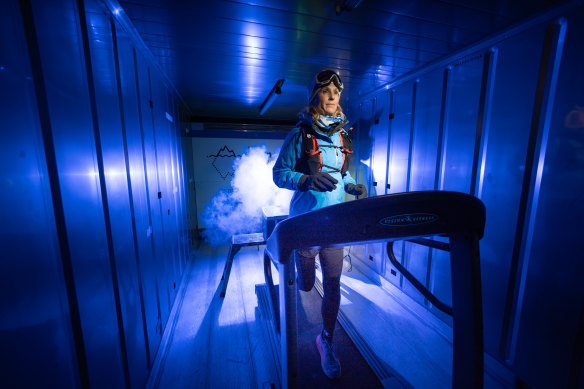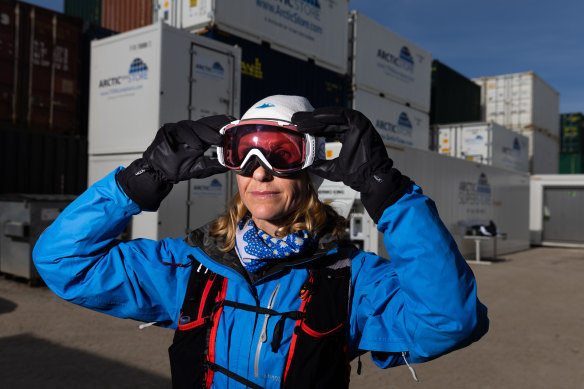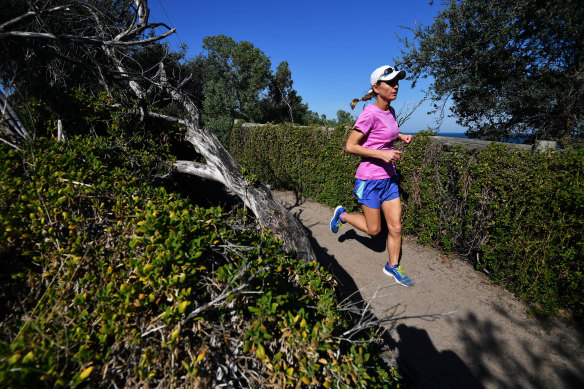Cool running: To tackle an ultramarathon in Antarctica, start by training in a freezer
Save articles for later
Add articles to your saved list and come back to them any time.
A cold-storage shipping container in Truganina – chilled as low as minus 10 degrees – is an extraordinary place to find a runner pounding away on a treadmill.
But ultramarathoner and pain scientist Associate Professor Donna Urquhart is attempting an extraordinary feat: to set a Guinness World Record for the longest polar ultramarathon.
Pain scientist Donna Urquhart on the treadmill in a freezer container as she prepares for her world record attempt in Antarctica.Credit: Jason South
In December, Urquhart will travel to Antarctica to try to surpass former politician Pat Farmer’s record of 1157 kilometres from Union Glacier camp to the South Pole, as part of his Pole to Pole expedition.
Antarctica is the coldest, windiest place on Earth, and Urquhart has been warned that while the temperature will generally hover between minus 5 and minus 10 degrees, it could drop below minus 20.
“The wind can get up to 100km/h and the wind chill with that can be very significant,” she says. “So you can imagine training in Melbourne for Antarctica is a big challenge.”
Urquhart daydreamed about training in a freezer. A Google search led her to TITAN Containers, which hires portable cold-store containers for frozen food and vaccines and cold-testing engineering components.
Urquhart is preparing to face temperatures that could drop below minus 20.Credit: Jason South
The company – which has become a major partner in her world record quest – provided access to a shipping container that can be cooled to minus 40 degrees.
Urquhart has long been fascinated with the nexus between pain, freezing temperatures and ultramarathoners.
A pain scientist at Monash University, her research has included ultramarathon runners and a control group plunging their hands into icy water until the pain became unbearable.
All 20 ultramarathoners kept their hands in the water for the maximum period of three minutes, while the control group averaged 58 seconds.
Urquhart has researched pain in athletes, and puts her findings to the test in ultramarathons.Credit: Joe Armao
The study – analysing the psychological reasons why athletes have higher pain tolerance than the normal population – found ultramarathon runners had less pain-related anxiety.
“So often, if people are anxious and fearful about things, they avoid that, so they’ll take their hand out of the water,” Urquhart says.
Ultramarathon runners participate in races that are longer than traditional 42-kilometre marathons.
Urquhart, who has competed in more than 50, including the gruelling 240-kilometre Coast to Kosciusko, is fascinated with exploring what is possible.
“I want to answer the questions: how far can humans go? How far can we run in a polar region? What are our limits? I am not a professional runner, I am a mum with a family who works and juggles training with life. I think many of us reach our limits because of our minds rather than our bodies.”
Urquhart also wants to encourage more girls and women to participate in sport, by being a role model but also by providing workshops on integrating mental strategies with physical skills.
When Urquhart is running ultramarathons, she tries not to think about the end point, which can feel overwhelming. If she is in pain, she analyses its source. Is it musculoskeletal, or nutrition, or fatigue, and is there anything she can do about it?
“If it’s pain that’s related to the actual act of running for a long time, then it’ll be more about shifting my focus onto other things,” she says. “It might be anything from visualisation to focusing on who I want to be at that moment, rather than the outcome.”
In the final four hours of 24-hour ultramarathons, when her body is spent, Urquhart focuses on her breathing. “Not only does that help to calm me, but it almost becomes a bit of a meditative process. And so everything goes on focusing on breath by breath.”
Back in the shipping container in Truganina, Urquhart says it is too late to prepare her body physiologically for Antarctica.
Instead, her training is focused more on practicalities: how do you open a drink bottle when you are wearing gloves and mittens? Will her energy gels freeze if it is minus 20 degrees? What should she wear while running?
“A lot of people think you’ll be dressed up like a Michelin man, but in fact, what we do is wear reasonably thin layers,” she says. “The key is that I actually want to stay a little bit cool because if I overheat, the sweat dries and that can lead to getting cold and hypothermic.”
Urquhart believes the biggest challenge she will face in Antarctica will be her own mind. “Physically you can keep going, as long as you keep your mind under control.”
Start the day with a summary of the day’s most important and interesting stories, analysis and insights. Sign up for our Morning Edition newsletter.
Most Viewed in National
From our partners
Source: Read Full Article



